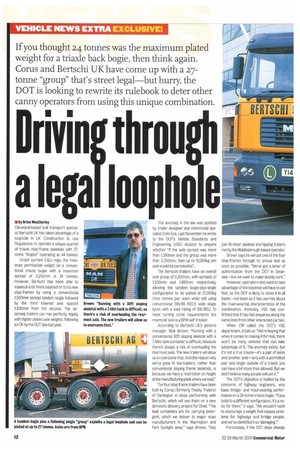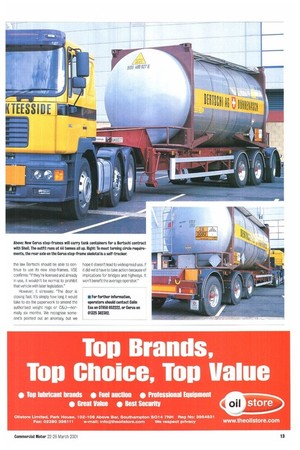throu loophole
Page 14

Page 15

If you've noticed an error in this article please click here to report it so we can fix it.
• by Brian Weatherley Cleveland-based bulk transport specialist Bertschi UK has taken advantage of a loophole in UK Construction & Use Regulations to operate a unique quartet of triaxle step-frame skeletals with 27tonne "bogies" operating at 44 tonnes.
Under current C&U regs, the maximum permissible weight on a conventional triaxle bogie with a maximum spread of 3,250mm is 24 tonnes. However, Bertschi has been able to squeeze a bit more payload on to its new step-frames by using a conventional 1,500mm spread tandem bogie followed by the third steered axle spaced 1,800mm from the second. The airsprung trailers can run perfectly legally with higher plated axle weights, following an OK by the DOT late last yean The anomaly in the law was spotted by trailer designer and intermodal specialist Colin Ess. Last November he wrote to the DDT's Vehicle Standards and Engineering (VSE) division to enquire whether "if the axle spread was more than 1,360mm and the group was more than 3,250mm, then up to 10,000kg per axle would be permissible.
The Bertschi trailers have an overall axle group of 3,300mrn, with spreads of 1,500mm and 1,800mm respectively, allowing the tandem bogie-plus-single configuration to be plated at 27,000kg (nine tonnes per axle) while still using conventional 385/65 R22.5 wide single tyres with a load rating of 158/1601 To meet turning circle requirements the rearmost axle is a BPW self-tracker.
According to Bertschi UK's general manager, Nick Brown: "Running with a conventional 30ft sloping skeletal with a 7.48m tank container is difficult, because there's always a risk of overloading the rearmost axle. The new trailers will allow us to overcome that. And the reason why we've gone to low-loaders, rather than conventional sloping frame skeletals, is because we have a restriction on height at the manufacturing plant where we load."
The four-step frame trailers have been built by Cores (formerly Tinsley Trailers) of Darlington in close partnership with Bertschi, which will use them on a new domestic delivery project for Shell. "The tank containers are for carrying detergent, which we deliver to major soap manufacturers in the Warrington and Port Sunlight area," says Brown. They join 16 other skeletal and tipping trailers run by the Middlesbrough-based operator.
Brown says he will put one of the four step-frames through its annual test as soon as possible. "We've got a letter of authorisation from the DOT in Swansea—but we want to make doubly sure."
However, operators who want to take advantage of the loophole will have to act fast, as the DOT is likely to dose it in all haste—not least as it has worries about the road-wearing characteristics of the combination. Ironically, VSE has confirmed that it has had enquiries along the same lines from other interested parties.
When CM called the DDT's VSE department, it told us: "We're hoping that when it comes to making it for real, there won't be many vehicles that can take advantage of it. The anomaly exists, but it's not a true triaxle—it's a pair of axles and another axle—and with a permitted pair and single outside of a triaxle you can have a bit more than allowed. But we don't believe many people will use it."
The DDT's objection is fuelled by the concerns of highway engineers, who base bridgeand road-wearing performance on a 24-tonne triaxle bogie. "If you build to a different configuration, it's a nano for them," it says. 'We wouldn't want to encourage a weight that causes problems for highways and bridge people, and we've identified it as 'damaging'."
Fortunately, if the DOT does change the law Bertschi should be able to confinue to use its new step-frames. USE confirms: "If they're licensed and already In use, 4 wouldn't be normal to prohibit that vehicle with later legislation."
However, it stresses: The door is closing fast, It's simply how long it would take to do the paperwork to amend the authorised weight regs or MU—normally six months. We recognise someone's pointed out an anomaly, but we hope it doesn't lead to widespread use. If it did we'd have to take action because of implications for bridges and highways. It won't benefit the average operator."
































































































